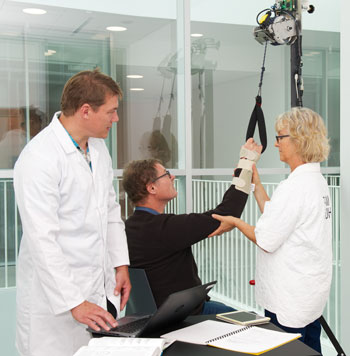
New rehabilitation robot counteracts gravity
A new, highly sensitive robot will help patients who can't raise their arms. The robot counteracts the force of gravity and makes training easier by interpreting the patient's rehabilitation requirements.
RoboTrainer Light is the third generation of robots designed for rehabilitation developed at the Maersk Mc-Kinney Moller Institute. It consists simply of a nylon string connected to a motor. When the patient pulls the string, the motor compensates for the weight of the arm and in this way the muscles can be excercised, even though the patient isn't strong enough to lift their own arm.
"It can be compared to standing under water in a swimming pool and moving your arms. It requires some effort even though your arms are supported by the water," says Associate Professor Anders Stengaard Sørensen.
Its simple construction makes the robot both cheap to produce and easy to use, and the very fact that training can be done in the patient's own home is a great advantage.
Cooperation with former soldier
The first rehabilitation robot from the Maersk Mc-Kinney Moller Institute, RoboTrainer, was developed in collaboration with Allan Lauritsen. He was paralysed in many parts of his body after a fall that damaged bones and muscles in his arm, shoulder and leg.
Contrary to doctors' prognoses, Allan Lauritsen regained most of his physical abilities using a training programme he developed himself. In 2011, Allan Lauritsen contacted the Maersk Mc-Kinney Moller Institute and in collaboration they developed the first RoboTrainer, based on Allan Lauritsen's training programme. See how in the video.
For more information contact
Associate Professor Anders Stengaard Sørensen at anss@mmmi.sdu.dk / mobile 2478 2365
RoboTrainer Light is part of the Patient@home project.